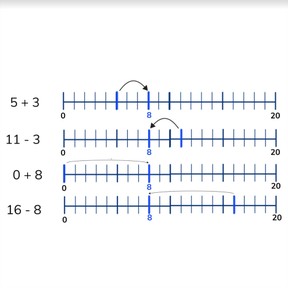8,000 schools use Gynzy
92,000 teachers use Gynzy
1,600,000 students use Gynzy
General
Students learn that you can have different math problems that equal the same number, and that they can be addition or subtraction problems.
Common core standard(s)
2.OA.B.2
Relevance
It is useful for students to recognize that there are multiple routes to reach an answer. Addition or subtraction problems can equal the same amount. By becoming more familiar with these multiple routes, they make addition and subtraction easier.
Introduction
Start by asking the class if they can come up with a math problem with numbers less than 20 which equals 8. Then ask students if they can come up with another addition problem that equals 8, as well as.a subtraction problem that equals 8. Then ask a few randomly selected students to come up to the board to solve the given math problems.
Development
Start the lesson by explaining that you can use different kinds of math problems to reach a desired answer. Explain that by knowing this, you can use an addition or subtraction problem to reach the desired answer. Then discuss that much like you use a map to determine which route to travel, you can use multiple routes (of addition or subtraction) to reach the destination number you want up to 20. Show this with an example on the interactive whiteboard with the answer 8 and then as a class to the number 11. Ask a student to come up with a math problem that equals 12. Then ask another student to drag the addition problem in front of the answer, and the subtraction problem after the number. Then ask the class to come up with an addition and a subtraction problem for the given number. Then ask students to come up with as many addition or subtraction problems possible for a given answer. First let them think for one minute, then repeat but only given them 50 seconds, and finally do this again but only give them 40 seconds. Tell students that by asking them to perform under time pressure they train their brains to see the multiple routes quicker which makes math easier!
Check that students are able to find multiple routes to numbers up to 20 by asking the following questions:
- Why is it useful to find multiple routes to the same number?
- Who can come up with an addition and subtraction problem that equals 14?
Guided practice
Students are given two types of problem. One in which they must drag the given math problems to their correct answer, and one in which they must select the math problems that equal a given number. In both cases, remind students that they need to look carefully at the math problems.
Closing
Start by checking that students understand the learning goal and the value of being able to find multiple routes to numbers up to 20 and ask them why it is useful to be able to do so. Then play memory with math problems and answers. Ask each student to come up with three sets of math problems. Give each student nine cards. On one card they write an addition problem, the second a subtraction problem, and the third card has the answer that fits with both the addition as well as the subtraction problem. Repeat this for the second and third set of cards. Then the students mix their cards with another student and they play memory. They must turn over all three cards to make the set. It is easiest to play this game in pairs.
Teaching tips
Students who have difficulty with this learning goal can be supported by starting with small numbers. Have them come up with addition problems and subtraction problems that equal 2. If that goes well, you can try addition and subtraction problems to 10 ,and then 20.
Instruction materials
Cards or pre-cut paper in sets of 3 to make memory game with.
The online teaching platform for interactive whiteboards and displays in schools
Save time building lessons
Manage the classroom more efficiently
Increase student engagement
Discover more!
About Gynzy
Gynzy is an online teaching platform for interactive whiteboards and displays in schools.
With a focus on elementary education, Gynzy’s Whiteboard, digital tools, and activities make it easy for teachers to save time building lessons, increase student engagement, and make classroom management more efficient.







